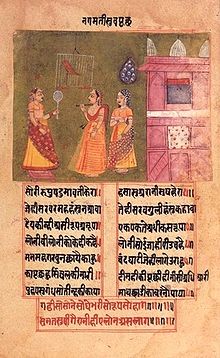
Back بادمافات Arabic পদ্মাৱত Assamese पद्मावत AWA Padmavat Spanish पद्मावत Hindi Padmavat ID Padmāvat Italian ਪਦਮਾਵਤ Punjabi Padmavat (poemat epicki) Polish پدما وت PNB
This article needs additional citations for verification. (October 2021) |
 "Queen Nagmati rashly asks her new parrot who is more beautiful, she or his former owner Princess Padmavati of Sri Lanka. Naturally, she gets a displeasing answer." An illustrated manuscript of Padmavat, c. 1750 | |
| Author | Malik Muhammad Jayasi |
|---|---|
| Language | Persian and Awadhi |
| Genre | Historical Fiction Epic poetry |
| Set in | 13th–14th century India |
| Published | 1540 |
| Publication place | India |
| Text | Padmavat at Wikisource |
Padmavat (or Padmawat) is an epic poem written in 1540 by Sufi poet Malik Muhammad Jayasi,[1] who wrote it in the Hindustani language of Awadhi,[2][3] and originally in the Persian Nastaʿlīq script.[4] It is the oldest extant text among the important works in Awadhi.[5] A famous piece of Sufi literature from the period, it relates an allegorical fictional story about the Delhi Sultan Alauddin Khalji's desire for the titular Padmavati, the Queen of Chittor.[6] Alauddin Khalji and Padmavati's husband Ratan Sen are historical figures, whereas Padmavati may have been a fictional character.[7]
- ^ "Absurdity of epic proportions: Are people aware of the content in Jayasi's Padmavat?". 24 November 2017.
- ^ Padmavati isn’t history, so what’s all the fuss about?
- ^ Cite error: The named reference
businesswas invoked but never defined (see the help page). - ^ Ramya Sreenivasan 2007, p. 30.
- ^ Meyer, William Stevenson; Burn, Richard; Cotton, James Sutherland; Risley, Herbert Hope (1909). "Vernacular Literature". The Imperial Gazetteer of India. Vol. 2. Oxford University Press. pp. 430–431. Retrieved 6 April 2009.
- ^ "'Padmavat' reminds us that a major casualty of the gory Rajput conflicts were Rajput women". 25 November 2017.
- ^ Asher, Catherine B.; Talbot, Cynthia (2006). India Before Europe. Cambridge University Press. p. 106. ISBN 9780521809047.
© MMXXIII Rich X Search. We shall prevail. All rights reserved. Rich X Search